City Way is perhaps the largest project under construction in the downtown area. I find the design of the project to be refreshing, and perhaps the way of the future for the city. Instead of pinning our hopes on a splashy new high-rise, City Way is instead a collection of solid mid-rise buildings. I believe this leads to greater interaction with the street in a way that the city’s new taller buildings seem to struggle with.
CityWay as seen from the sidewalk next to Conseco Fieldhouse:
A closer look at the residences:
The centerpiece of the project is the Alexander Hotel:
‘One more look at the residences:
The leasing office sits where the YMCA will be located:
The Alexander from the corner of Delaware and South:
The northeast corner of Alabama and South also has a rendering of a future office building that was posted on the Property Lines blog.
This project is a good example of taking an underutilized surface parking lot and turning it into an asset for the city. Â It’s a solid design that is unique in the city, and it complements the downtown setting with mixed-use structures and a new YMCA facility.
Another interesting part of this project is the conversion of Delaware Street from a one-way to a two-way thoroughfare, as seen in these 2 DPW PDF files (here, and here). The maps of the streetscape improvements are shown below:
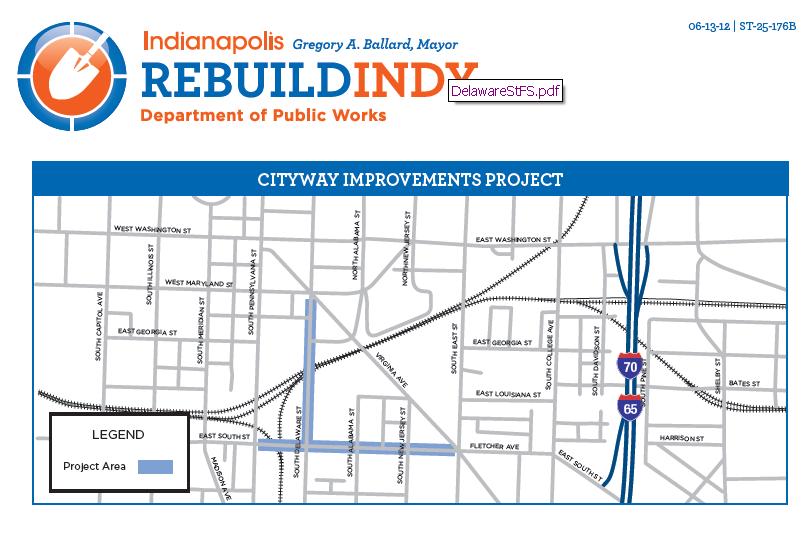

The 2 way conversion on Delaware could help to mitigate the speed of traffic near the project. Â Also, this location would have otherwise proved difficult to visit from downtown. Â It’s good to see such an interest in a formerly dead part of town, and I think that Lucas Oil Stadium’s location might have renewed interest in South Street’s many empty lots.



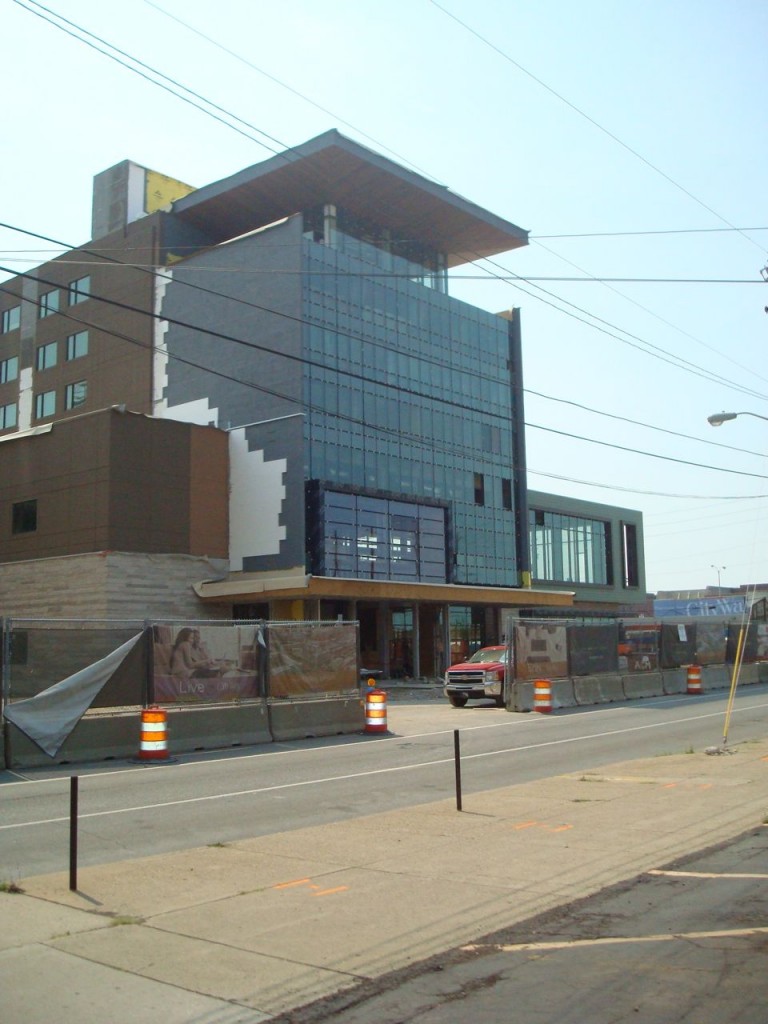
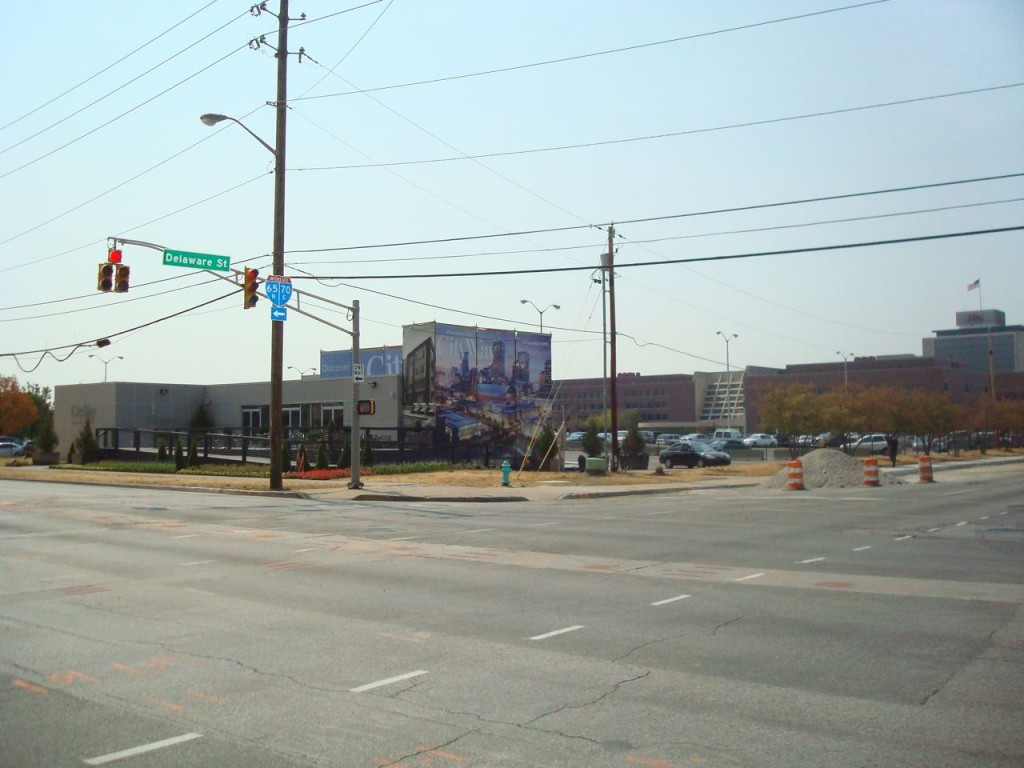
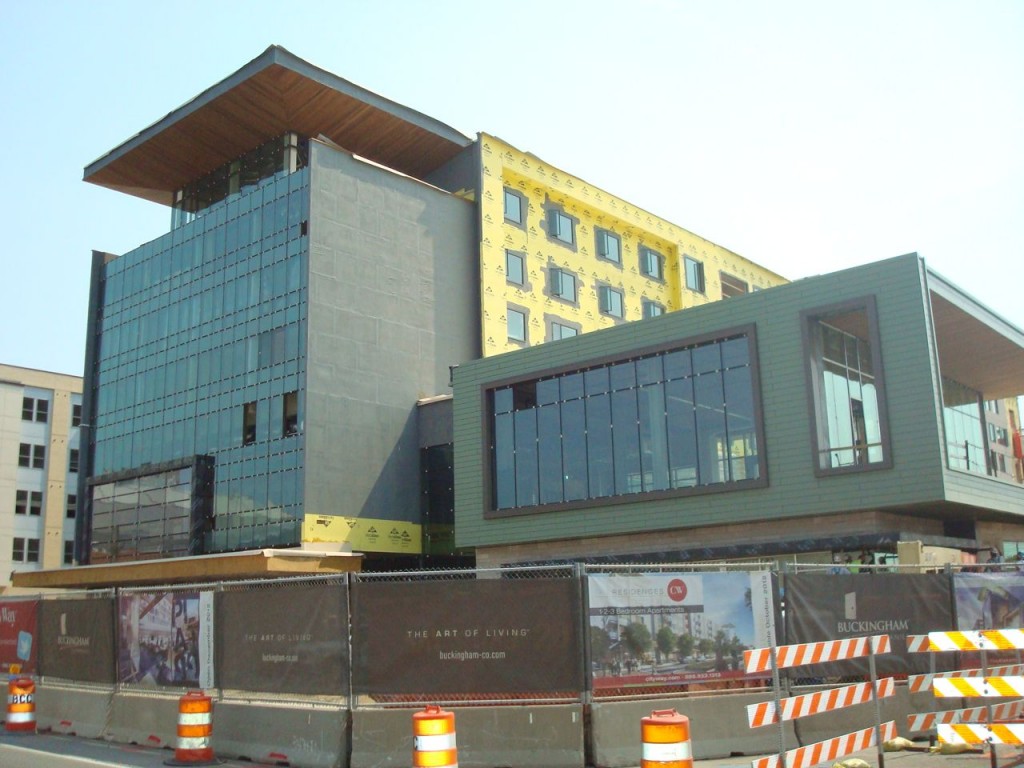
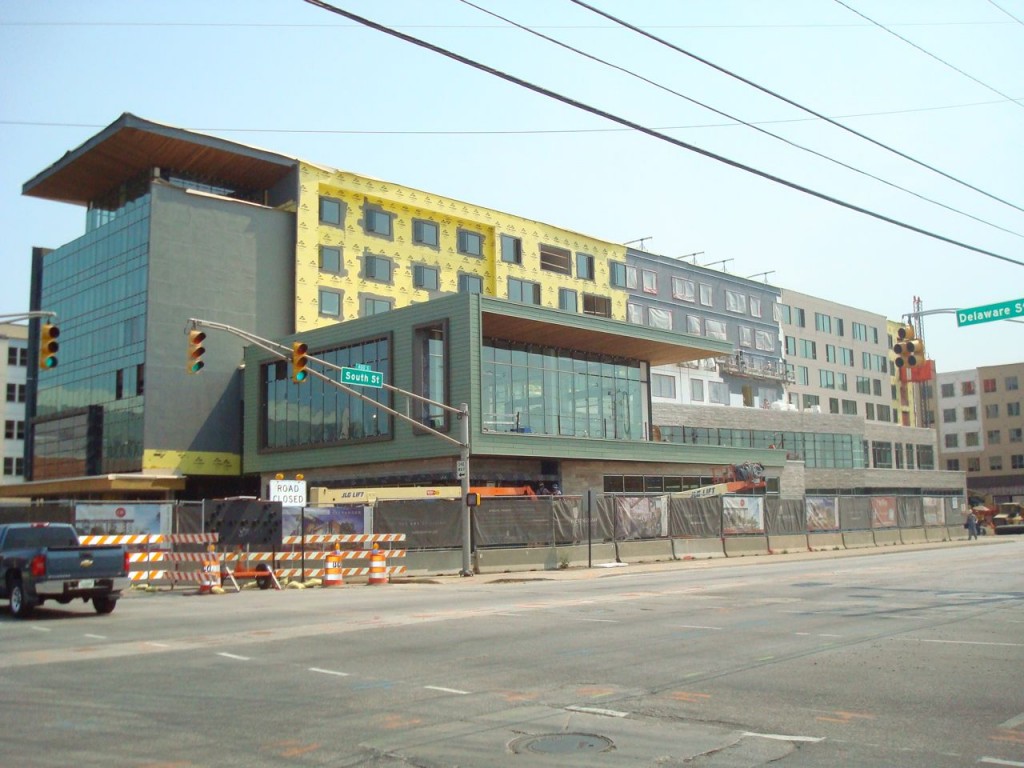


Making Delaware 2-way is bound to mangle traffic flow for the southsiders heading downtown as well as creating a hazard where those exiting Lilly’s garage (erm, ‘parking structure’) mix with the new flow from Delaware.
Don’t like.
Thought Lilly’s parking garage was between Penn and Delaware south of South Street…that part of Delaware will remain one-way.
They are taking the 2-way all the way to Merrill. I will let others debate the merits of this. I hope it is pulled off well, but I could also see this being a big issue:
From the second linked pdf:
New depressed planting areas will be installed within
the limits of Delaware Street running and south of
the Merrill Street intersection separating the north
bound and south bound lanes of traffic, completing
the conversion from one-way northbound to a two-way
north and southbound street.
I doubt it’s going to create much of a traffic issue. Delaware is a monstrously wide street, basically all the way from where Madison splits into Delaware/Penn up to Fall Creek Parkway. Down in this area, it’s 5 lanes wide, which is absurd for the amount of traffic flowing on it. According to city records from 2003, it sees 21,686 cars/day. That’s a lot, to be sure, but could easily be accommodated on fewer lanes. Meridian St. between I65 and Fall Creek sees 45-50k cars/day with two lanes each direction without much problem. In that same area, College Ave. has 2 northbound and 1 southbound lane and smoothly carries over 30k cars/day.
.
I’m not sure what configuration they’re proposing, but it will surely remain biased toward northbound travel in terms of number of lanes and light timing. I wouldn’t worry about it too much.
The siteplan on CityWay’s website shows that the lane configuration will be 3 northbound and 1 southbound. 21,686 on 3 northbound lanes is a piece of cake. You could arguably squeeze that into two lanes without choking off traffic flow.
I agree, though 2/2 might be better north of South. And I guess the conversion down to Merrill will improve flow to and from the Gates of Lilly (where Merrill was abandoned east of Delaware).
Chris – Three problems with your response. First, the stats you provide are seriously outdated. But let’s go with them anyway. Second, the traffic on Meridian or College is more spread out during the course of an entire day. The traffic on this stretch of Delaware is concentrated between 7am and 9am. Consider it a daily tidal wave of cars that lasts about two hours. Third, remove a lane for cars turning left – there are a bunch of them that do and effectively choke off a lane for thru-traffic. If not mistaken left turns are forbidden on Meridian Street during certain hours of the day. Then, account for stoppage of traffic mid-block from an additional pedestrian crossing not at an intersection and account for traffic lights that are too short and not in sync and you get a better picture of the situation. I perceive you have never driven this affected stretch of Delaware during morning rush hour. It is my hope that city planners will either abandon the plan or dedicate all lanes to northbound traffic during morning rush – say 6am to 9am – as it has with other thoroughfares around town.
Is not the biggest problem with Delaware Street traffic flow caused by the signal at Washington Street that is not in sync with any of the others? Does anyone know anything about any discussions to resequence the Washington Street lights? The problem is caused by the fact that the Washington Street signals now all have longer phases than all the other signals downtown, because of the separate phases for pedestrians and right turns across the C.T.; thus the lights can’t be synchronized with those of the north-south streets, which are otherwise all synched because they have equally timed phases. With Indy being such an auto-centric town, I’m surprised I haven’t heard more outrage about this yet.
Designing our street for a 2 hour stretch every day is ridiculous. If we design the street properly, then the people commuting by car will find a better way to get there and the net benefit will be streets that are safer, encourage more activity and demand for store fronts, hotels and apartments will be great. This is placemaking 101. Willk there be growing pains? Yes. There always is. But to say that we should dedicate this many lanes for people who chose to live outside the area and in some cases, arent even paying taxes (suburban county commuters) this is MORE than fair.
You’re creating a new neighborhood here. You’re not supposed to pander to suburban commuters. Think what you’d want in your community.
I’d want my community to recognize there are going to be a lot of suburban commuters whether I like it or not and I would want my leaders to figure out how to get those commuters through my neighborhood with minimal congestion, noise and pollution.
Sorry, Mike. I don’t want to see downtown residents kowtowing to suburban commuters. Those of us who live downtown have moved here for a reason and that is to avoid traffic and to focus on a pedestrian and biking lifestyle. The last thing we want is 45mph cars flying through our downtown neighborhoods.
Thanks for the update. No question this project with mid-rise mixed use buildings is great for downtown. When the project first came out, it sounded like it would have that corporate island feel. I was afraid it would not connect well with its surroundings, but it’s turning out better than I expected.
In that very first picture…wouldn’t it be great to have several stories of structure on top of the retaining wall? The wall holds up a surface parking lot…a couple of stories of residential or office above that would be interesting, and would fill the hole in the sky between the Conseco, er, Bankers Life parking garage and City Way.
“Asset to the City?” We taxpayers will have absolutely no ownership in CityWay. Yet another example of the City providing the financial backing and not getting anything in return.
I meant that phrase in terms of new restaurants and such to visit. Again, I’d like to keep out of the sniping here if possible.
How about a shout out to the taxpayers of Indianapolis who are financing the entire deal which was put together by a major Ballard contributor?
Louis – I will assume your assertion is correct. The thought had crossed my mind that this was a political favor to the developer and to big business. It just had all the markings of “favor” written on it. Why make Delaware two-way? Is it so hard for the relatively few residents and patrons of CityWay to just go around the block?
I don’t mind this brand of financing. At the time of the announcement, it was maybe a big hedge, but construction is still underway, and a good portion of the commercial is already leased. Not only that, with the amount of business traffic driven by Lilly, the hotel is likely to be well used.
.
As an urbanist, I like this project because IMO, its low risk for high potential return. We erased a large surface parking lot and created something much more useful for the land. Plus, it looks much nicer than most other recent developments in the city.
.
This taxpayer doesnt mind financing the construction. We are already seeing returns on the investment
I’m curious as to what other streets may be considered for conversion to two-way in the future? I know College Avenue was being discussed here a while back and College itself was made two-way north ot 10th Street a while ago. What other streets would be candidates for a two-way conversion? Could Pennsylvania be converted to match with Delaware Street, how about Illinois and Capitol or New York and Michigan, any thoughts on this?
I have heard that Central is to be turned to two way between Fairfield and Fall Creek.
Chris Corr has mentioned that Alabama and New Jersey seem ripe for conversion, and I think those would also be possible targets.
I think you mean “Central is to be turned to TWO way”. And C-C Council has already passed the ordinance. It’s just a matter of execution now.
Yes, I fixed that for clarification.
I’ll leave others more knowledgeable than me to debate the merits and appropriateness of the financing, but I’ll echo those who feel the project is a nice addition to an area of town that hadn’t seen much development. It’s visually more interesting than a lot of what we have downtown, particularly the hotel. But we shouldn’t get too excited about the business Lilly will bring to that property since is likely will take those room nights away from other downtown hotels where people were previously staying.
I think the design of this complex was well done. In a few months when the hotel is full and there are flower baskets on the residential balconies this whole area is going to come alive. We didn’t just get some new buildings, we gained what will soon be a new neighborhood.
Also, I’m glad that non-traditional financing was considered. We shouldn’t forget what the large loan markets were like when this was done, the worst economy since the Great Depression. I do understand there were some loan contract terms that were not in the public’s best interest, and it’s a shame too because otherwise this would have been a grand slam instead of just a home run.
There could be some actual detail at the ground floor level to encourage pedestrian activity. People do not want to walk from sameness to sameness.
If the ground floor commercial isn’t filled with the appropriate uses to create street life, it’s not going to matter if it’s two-way or one-way, anyways.
Funny. Regardless of city, or street people will predict carmageddon will occur if a street goes two-ways. Almost always people figure it out quickly and then forget it was ever one-way…
That’s a messed up view of ROI. What you get are new places to spend money… the opposite of ROI. The only one with positive ROI is the developer/property manager. The city might make a little bit of money from property and sales taxes.
Couldn’t be happier about this. I live over in Fletcher Place and am happy to have lots of commercial action happening in this area. I can’t wait for the YMCA to open as well.
.
I think switching Delaware to two way is a good thing. Delaware is a racetrack all the way from, well, where does 31 start? Louisville?
.
Is Lilly planning on connecting Merrill St through as a pedestrian thoroughfare across their campus any time soon? A little jaunt off the Cultural Trail to Merrill and East could cross Lilly to the viaduct between Delaware and Penn. Then there is a nice walkway over between Meridian/Madison/Illinois. Could get people almost all the way to Lucas Oil.
People already walk from Fletcher Place across the parking lots and new “urban prairie” south of South to Merrill and across to LOS. I’m one of ’em, and can’t wait until Lilly opens the gate on the former Merrill St. all the way across.
Nope. Creating a two-way street won’t cause any catastrophe. Center Township has an incredible excess of roadway capacity. You can see the evidence every time there is a lane closure on a major roadway. Latest example, Washington Street being one lane westbound through Irvington during construction. Major traffic snarls? Nope. The same has been evidenced when Michigan Street and New York Street were each reduced to one lane a couple years ago during major construction for the Pogues Run sewer project. Massive congestion? Nope. Just about every one-way arterial in Center Township could be made two-way, with great benefits for the adjacent properties and neighborhoods, with few negatives.
I don’t understand why the City or cyclists or pedestrians or public transportation advocates would want to convert these large one way streets to two way streets. Is that not a short sided/band-aide-type remedy? Has there been any discussion in the City governments about turning one of the lanes (on the larger one way streets) into a “fortified bicycle lane” i.e Shelby St.? Or reducing parking on these streets to accommodate/encourage/facilitate alternative means of getting to and through the downtown area?
In my hometown more streets are turning into one-ways, reducing/discouraging surface street parking, and expanding bicycle and pedestrian facilities and public transportation.
When and where are City meetings like this? I would like to participate.
I’d say the quick answer to why people would want streets converted to two-way is because most people don’t like to live along, or walk along high-volume one-way streets. One of the key ideas is that two-way traffic results in slower traffic that is less noisy and makes for a more appealing environment for people not in cars. It also makes it more convenient to reach businesses in homes when one doesn’t need to go out of their way navigating one-way streets. I agree that something similar to the Shelby Street protected bike lanes should be replicated along many more streets, but that can be done on either one-way or two-way streets.
That’s a bit overrated. There are plenty of successful one-way streets. The key is to have parallel parking and a bike lane to buffer pedestrians and successful shops and public spaces that generate foot traffic.
I don’t see any mention of LEED in this project though early on it was suggested that the developer was seeking LEED silver designation. Anybody have an update?
The obvious reason for converting the one way streets to 2 way is to increqse quality of living (traffic calming, better street life for both business and residential…etc). While downtown will continue to rely on one ways to ease traffic in and out of the city during peak business hours and events, it’s clear a number of these one way streets can be converted without any major issues. Not really sure how one way streets discouraging surface parking (as mentioned above) is a good thing? Seems like a convenient solution for moving vehicles and/or other modes through lifeless streetscapes. Turning Delaware and College into 2 ways will only promote community development and create a more connected environment—which isn’t a bad thing.
The city needs a mixed development between high-rise and mid-rise.
As a resident of the Old Northside, I would like to Central Avenue two way from 38th St to downtown. College was changed some time back with little issue. Presently Central is a racetrack that runs right through the middle of our Histroric District (and others). Would make a big difference to the livability of these neighborhoods.
Central, I believe, is the worst one way street in downtown
What’s most ridiculous is the 35MPH speed limit, especially on the section between 16th & 10th which appears narrower, but maybe it’s just the prevalence of parked cars. When I drive it, I think anything over 25MPH is too fast, with the narrow lanes and the chance that a kid of dog or anything might dart out from between parked cars. I’ve often wondered if people in that neighborhood have ever lobbied the City to lower the speed limit.
In response to:
Curt Ailes says:
July 17, 2012 at 12:51 pm
Designing our street for a 2 hour stretch every day is ridiculous. If we design the street properly, then the people commuting by car will find a better way to get there and the net benefit will be streets that are safer, encourage more activity and demand for store fronts, hotels and apartments will be great. This is placemaking 101. Willk there be growing pains? Yes. There always is. But to say that we should dedicate this many lanes for people who chose to live outside the area and in some cases, arent even paying taxes (suburban county commuters) this is MORE than fair.
Not sure why the site wasn’t allowing me to respond at the appropriate location in the comments, but… I agree with everything you said. However, I don’t think it’s unreasonable that we try to accommodate commuters as best we can, within reason. By that I mean, we ought to be able to have the signals synchronized to keep traffic flowing, albeit more slowly than what most of the downtown streets now appear to be timed for. I would think that intelligent traffic engineers would be able to come up with a way to design the traffic signals to accommodate the uniqueness of the Cultural Trail without excessively causing additional congestion on Washington Street, as well as all of the north-south streets. Am I being unrealistic? Is this a concern to others?